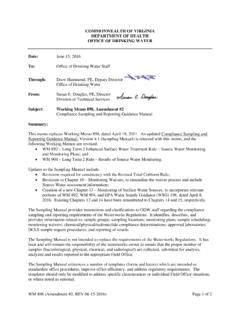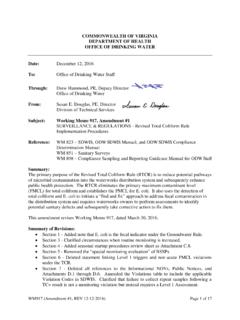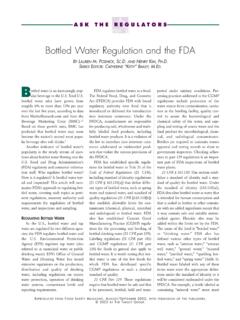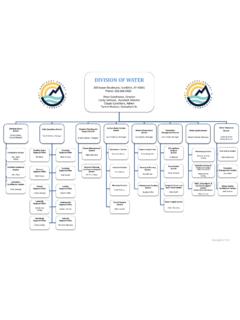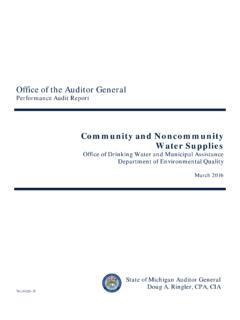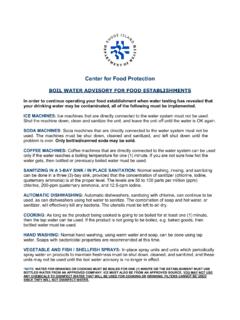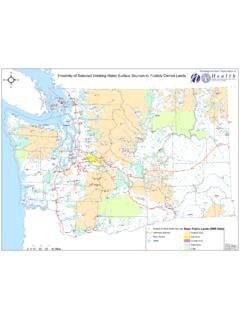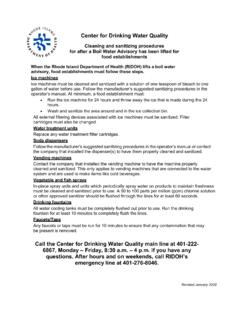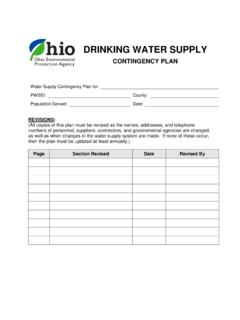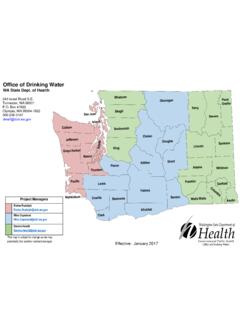Transcription of 2018 Edition of the Drinking Water Standards and Health ...
1 2018 Edition of the Drinking Water Standards and Health Advisories Tables The 2012 Drinking Water Standards and Health Advisories (DWSHA) Tables were amended March 2018 to fix typographical errors and add Health advisories published after 2012. 2018 Edition of the Drinking Water Standards and Health Advisories EPA 822-F-18-001 office of Water Environmental Protection Agency Washington, DC March 2018 Recycled/Recyclable Printed on paper that contains at least 50% recycled fiber. Drinking Water Standards and Health Advisories March 2018 Page iii of viii The Health Advisory (HA) Program, sponsored by the EPA s office of Water (OW), publishes concentrations of Drinking Water contaminants at Drinking Water Specific Risk Level Concentration for cancer (10-4 Cancer Risk) and concentrations of Drinking Water contaminants at which noncancer adverse Health effects are not anticipated to occur over specific exposure durations - One-day, Ten-day, and Lifetime - in the Drinking Water Standards and Health Advisories (DWSHA) tables.
2 The One-day and Ten-day HAs are for a 10 kg child and the Lifetime HA is for a 70 kg adult. The daily Drinking Water consumption for the 10 kg child and 70 kg adult are assumed to be 1 L/day and 2 L/day, respectively. The Lifetime HA for the Drinking Water contaminant is calculated from its associated Drinking Water Equivalent Level (DWEL), obtained from its RfD, and incorporates a Drinking Water Relative Source Contribution (RSC) factor of contaminant-specific data or a default of 20% of total exposure from all sources. Maximum Contaminant Levels (MCLs) and Maximum Contaminant Level Goals (MCLGs) for some regulated Drinking Water contaminants are also published. HAs serve as the informal technical guidance for unregulated Drinking Water contaminants to assist Federal, State and local officials, and managers of public or community Water systems in protecting public Health as needed. They are not to be construed as legally enforceable Federal Standards .
3 EPA s OW has provided MCLs, MCLGs, RfDs, One-Day HAs, Ten-day HAs, DWELs, Lifetime HAs, Drinking Water Specific Risk Level Concentration for cancer (10-4 Cancer Risk), and Cancer Descriptors in the DWSHA tables. HAs are intended to protect against noncancer effects. The 10-4 Cancer Risk level provides information concerning cancer effects. The MCL values for specific Drinking Water contaminants must be used for regulated contaminants in public Drinking Water systems. The DWSHA tables are revised periodically by the OW so that the benchmark values are consistent with the most current Agency assessments. Reference dose (RfD) values are updated to reflect the values in the Integrated Risk Information System (IRIS) and the office of Pesticide Programs (OPP) Reregistration Eligibility Decisions (REDs) documents. The associated DWEL is recalculated accordingly. The 2018 DWSHA tables do not reflect assessments from IRIS or OPP published from 2012 to 2018.
4 The DWSHA tables are currently undergoing a modernization effort to move the relevant HA information into a web-based format. This posting of the 2018 DWSHA tables is an intermediate step to address typographical errors and include Health advisories published since the 2012 tables were published. A Lifetime noncancer benchmark is made available to risk assessment managers for comparison to the cancer risk level Drinking Water concentration (10-4 Cancer Risk) and to determine whether the noncancer Lifetime HA or the cancer risk level Drinking Water concentration provides a more meaningful scenario-specific risk reduction. In this regard, the office of Water defines the Lifetime HA as the concentration in Drinking Water that is not expected to cause any adverse noncarcinogenic effects for a lifetime of exposure, whereas the 10-4 Cancer Risk is the concentration of the chemical contaminant in Drinking Water that is associated with a specific probability of cancer.
5 The office of Water also advises consideration of the more conservative cancer risk levels (10-5, 10-6), found in the IRIS or OPP RED source documents, if it is considered more appropriate for exposure-specific risk assessment. Drinking Water Standards and Health Advisories March 2018 Page iv of viii Many of the values on the DWSHA tables have been revised since the original HAs were published. Revised RfDs, 10-4 Cancer Risk values, and cancer designations or descriptors obtained from Integrated Risk Information System (IRIS) are presented in BOLD type. Revised RfDs, 10-4 Cancer Risk values, and cancer designations or descriptors obtained from office of Pesticide Program s Registration Eligibility Decision (OPP RED) are presented in BOLD ITALICS type. The summaries of IRIS Toxicological Reviews from which the RfDs and cancer benchmarks, as well as the associated narratives and references can be accessed at: Those from OPP REDs can be accessed at: In some cases, there is an HA value for a contaminant but there is no reference to an HA document.
6 Such HA values can be found in the Drinking Water Criteria Document for the contaminant. With a few exceptions, the RfDs, Health Advisories, and Cancer Risk values have been rounded to one significant figure following the convention adopted by IRIS. For unregulated chemicals with current IRIS or OPP REDs RfDs, the Lifetime Health Advisories are calculated from the associated DWELs, using the RSC values published in the HA documents for the contaminants. The DWSHA tables may be reached from the Water Science home page at: The DWSHA tables are accessed under the Drinking Water icon. Copies of the Tables may be ordered free of charge from SAFE Drinking Water HOTLINE 1-800-426-4791 Monday thru Friday, 9:00 AM to 5:30 PM EST Drinking Water Standards and Health Advisories March 2018 Page v of viii DEFINITIONS The following definitions for terms used in the DWSHA tables are not all-encompassing, and should not be construed to be official definitions.
7 They are intended to assist the user in understanding terms used in the DWSHA tables. Action Level: The concentration of a contaminant which, if exceeded, triggers treatment or other requirements which a Water system must follow. For example, it is the level of lead or copper which, if exceeded in over 10% of the homes tested, triggers treatment for corrosion control. Cancer Classification: A descriptive weight-of-evidence judgment as to the likelihood that an agent is a human carcinogen and the conditions under which the carcinogenic effects may be expressed. Under the 2005 EPA Guidelines for Carcinogen Risk Assessment, Cancer Descriptors replace the earlier alpha numeric Cancer Group designations (US EPA 1986 guidelines). The Cancer Descriptors in the 2005 EPA Guidelines for Carcinogen Risk Assessment are as follows: carcinogenic to humans (H) likely to be carcinogenic to humans (L) likely to be carcinogenic above a specified dose but not likely to be carcinogenic below that dose because a key event in tumor formation does not occur below that dose (L/N) suggestive evidence of carcinogenic potential (S) inadequate information to assess carcinogenic potential (I) not likely to be carcinogenic to humans (N) The letter abbreviations provided parenthetically above are now used in the DWSHA tables in place of the prior alpha numeric identifiers for chemicals that have been evaluated under the new guidelines (the 2005 guidelines or the 1996 and 1999 draft guidelines) or whose records in the DWSHA tables have been revised.
8 Cancer Group: A qualitative weight-of-evidence judgment as to the likelihood that a chemical may be a carcinogen for humans. Each chemical was placed into one of the following five categories (US EPA 1986 guidelines). The Cancer Group designations are given in the Tables for chemicals that have not yet been evaluated under the new guidelines or whose records in the DWSHA tables have been revised. Group Category A Human carcinogen B Probable human carcinogen: B1 indicates limited human evidence B2 indicates sufficient evidence in animals and inadequate or no evidence in humans C Possible human carcinogen D Not classifiable as to human carcinogenicity E Evidence of noncarcinogenicity for humans Drinking Water Standards and Health Advisories March 2018 Page vi of viii 10-4 Cancer Risk: The concentration of a chemical in Drinking Water corresponding to an excess estimated lifetime cancer risk of 1 in 10,000.
9 Drinking Water Advisory: A nonregulatory concentration of a contaminant in Water that is likely to be without adverse effects on Health and aesthetics for the period it is derived. DWEL: Drinking Water Equivalent Level. A DWEL is a Drinking Water lifetime exposure level, assuming 100% exposure from that medium, at which adverse, noncarcinogenic Health effects would not be expected to occur. HA: Health Advisory. An estimate of acceptable Drinking Water levels for a chemical substance based on Health effects information; an HA is not a legally enforceable Federal standard, but serves as technical guidance to assist Federal, State, and local officials. One-Day HA: The concentration of a chemical in Drinking Water that is not expected to cause any adverse noncarcinogenic effects for up to one day of exposure. The One-Day HA is intended to protect a 10-kg child consuming 1 liter of Water per day. Ten-Day HA: The concentration of a chemical in Drinking Water that is not expected to cause any adverse noncarcinogenic effects for up to ten days of exposure.
10 The Ten-Day HA is also intended to protect a 10-kg child consuming 1 liter of Water per day. Lifetime HA: The concentration of a chemical in Drinking Water that is not expected to cause any adverse noncarcinogenic effects for a lifetime of exposure, incorporating a Drinking Water RSC factor of contaminant-specific data or a default of 20% of total exposure from all sources. The Lifetime HA is based on exposure of a 70-kg adult consuming 2 liters of Water per day. For Lifetime HAs developed for Drinking Water contaminants before the Lifetime HA policy change to develop Lifetime HAs for all Drinking Water contaminants regardless of carcinogenicity status in this DWSHA update, the Lifetime HA for Group C carcinogens, as indicated by the 1986 Cancer Guidelines, includes an uncertainty adjustment factor of 10 for possible carcinogenicity. MCLG: Maximum Contaminant Level Goal. A non-enforceable Health benchmark goal which is set at a level at which no known or anticipated adverse effect on the Health of persons is expected to occur and which allows an adequate margin of safety.










